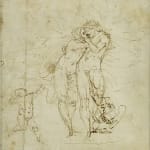Friedrich Sustris (Padua ca. 1540 - 1599 Munich)
Friedrich Sustris was born ca. 1540 in Padua, Italy. His father, Lambert Sustris, was a Netherlandish painter who worked in Italy and, later on, in Augsburg, as court painter to the Habsburg emperor Charles V. In 1560 Friedrich went to Rome, where he worked under Giorgio Vasari from 1563 – 1567, collaborating on the decorations of the Palazzo Vecchio and joining the Accademia del Disegno. In 1569, he went to Augsburg to work for Hans Fugger, a member of the fabulously wealthy banker family. This brought him to the attention of William V, the future duke of Bavaria, who he worked for from 1573 onwards. Sustris gradually rose from painter and copyist to become William’s artistic director, overseeing all artistic projects at his court.
He produced designs for goldsmiths, tapestry weavers, sculptors, and stucco workers and organized a team of painters to decorate the palace interiors. He strongly influenced building decoration, and many admired his light, rich, and elegant motifs. Sustris participated in design and reconstruction of a Jesuit church in Munich, one of the region’s architectural monuments, and designed the decoration of the Antiquarium, the first museum of antiquities in modern times. Stylistically, as can be seen in the present work, Sustris was influenced by both Italian and Flemish mannerism, which was very much in style in the second half of the 16th century.
One of his commissions was the decoration of the castle of Trausnitz, for which he painted numerous frescoes. The present drawing was probably executed sometime between 1573 and 1580, when he worked on the castle decorations. For instance, the figure of Semele can be compared to the face of a woman in his fresco “An Allegory of Discretion), while the figure of Jupiter closely resembles the Apollo in “The Assembly of Apollo and Pan” and the Alexander in the “Apotheosis of Hercules”. Furthermore, the drawing may be compared to works in the collection of the Queen of England (Windsor Castle, inv. 316), in the collection P. & N de Boer and in the Louvre (inv. 21178).
The story of Jupiter and Semele is recounted by Ovid in his Metamorphoses. The daughter of Cadmos and Harmonia, Semele became one of Jupiter’s many mistresses. Juno, jealous because of her husband’s adultery, convinced Semele to ask Jupiter to show himself to her in his full divine form, which killed her. In the present work however, the artist has chosen not to highlight this drama, but has focused on the more erotic aspects of the scene. As is evidenced by the presence of a sketch for the composition on the verso of the sheet (shown below), the present work was intended as a fully finished work of art in its own right, and not as a preparatory work.
Provenance
Collection Flury-Hérard (Lugt n°1015);
Private collection, France.



